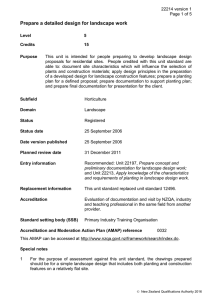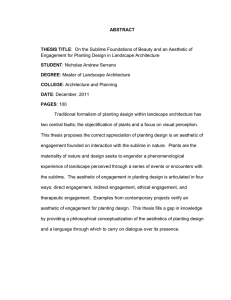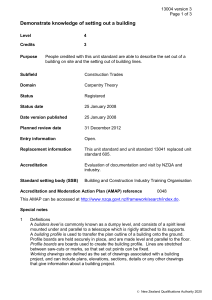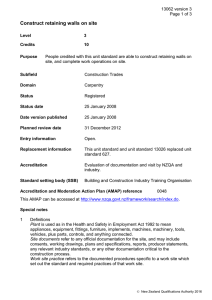Apply knowledge of the characteristics and requirements of planting in
advertisement
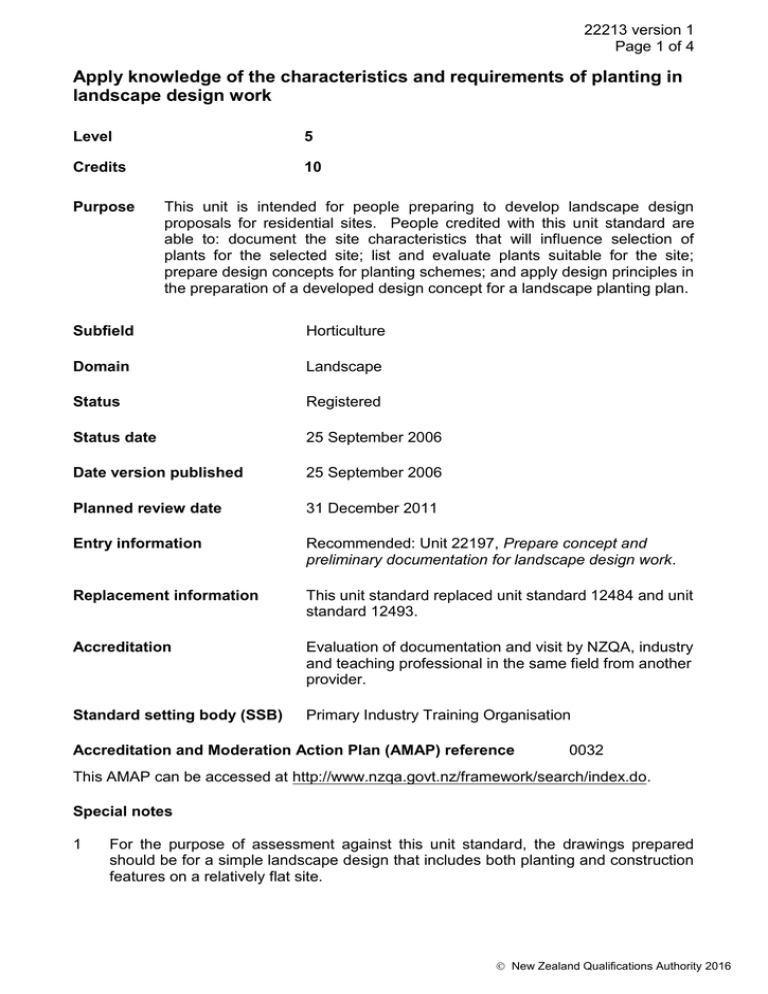
22213 version 1 Page 1 of 4 Apply knowledge of the characteristics and requirements of planting in landscape design work Level 5 Credits 10 Purpose This unit is intended for people preparing to develop landscape design proposals for residential sites. People credited with this unit standard are able to: document the site characteristics that will influence selection of plants for the selected site; list and evaluate plants suitable for the site; prepare design concepts for planting schemes; and apply design principles in the preparation of a developed design concept for a landscape planting plan. Subfield Horticulture Domain Landscape Status Registered Status date 25 September 2006 Date version published 25 September 2006 Planned review date 31 December 2011 Entry information Recommended: Unit 22197, Prepare concept and preliminary documentation for landscape design work. Replacement information This unit standard replaced unit standard 12484 and unit standard 12493. Accreditation Evaluation of documentation and visit by NZQA, industry and teaching professional in the same field from another provider. Standard setting body (SSB) Primary Industry Training Organisation Accreditation and Moderation Action Plan (AMAP) reference 0032 This AMAP can be accessed at http://www.nzqa.govt.nz/framework/search/index.do. Special notes 1 For the purpose of assessment against this unit standard, the drawings prepared should be for a simple landscape design that includes both planting and construction features on a relatively flat site. New Zealand Qualifications Authority 2016 22213 version 1 Page 2 of 4 2 Design enterprise standards and/or procedures may include but are not limited to quality assurance, documentation, security, communication, health and safety, ethics, interpersonal behaviour and design. An acceptable standard would be comparable to ISO9000 certified enterprises and /or organisations, and those standards set by an incorporated professional or trade body such as Landscape Industries Association of New Zealand or New Zealand Institute of Landscape Architects. 3 Legislation relevant to the client’s needs and requirements may include but is not limited to the Health and Safety in Employment Act 1992, Building Act 2004, Consumer Guarantees Act 1993, Fair Trading Act 1986, Privacy Act 1993, and the Resource Management Act 1991. Elements and performance criteria Element 1 Document the site characteristics that will influence selection of plants for the selected site. Performance criteria 1.1 General site characteristics are documented to design enterprise standards. Range 1.2 Completed documentation defines any areas within the site that are unusual or of particular significance in terms of plant selection requirements and is in accordance with design enterprise procedures. Range 1.3 site characteristics may include but are not limited to – aspect, climate, soil type and condition, shelter, shade, existing features and plants. apparent microclimates, potential problem areas, areas appropriate for theme development based on plant characteristics. Ecological relationships in plant communities are described in relation to the site. Range indigenous communities, typical associations, interaction of indigenous and introduced species, biodiversity. Element 2 List and evaluate plants suitable for the site. Performance criteria 2.1 Listed plants for possible use in the landscape design are described in terms of their characteristics. Range colour, form, texture, smell, growth patterns, evergreen and/or deciduous, ultimate size, toxicity. New Zealand Qualifications Authority 2016 22213 version 1 Page 3 of 4 2.2 Site requirements of the listed plants are described in accordance with design enterprise procedures. Range tolerance levels, soil water and nutrient requirements, seasonality, sun and/or shade. Element 3 Prepare design concepts for planting schemes. Range three schemes required – two thematic plantings, one ecological association. Performance criteria 3.1 Concepts show use and understanding of design elements and principles. Range 3.2 at least two design elements and two principles are required in each concept. Plant options chosen for the planting schemes reflect levels of knowledge of plant characteristics to professional design enterprise standards. Range plant characteristics may include but are not limited to – physical, aesthetic, seasonal, life span, maintenance requirements. Element 4 Apply design principles in the preparation of a developed design concept for a landscape planting plan. Performance criteria 4.1 Resource material required for development of planting plan is assembled. Range 4.2 Existing concept drawings are analysed to determine design intentions for planting areas in terms of functional applications and aesthetic principles. Range 4.3 material may include but is not limited to – concept drawings, lists of plants compatible with site conditions, client brief, availability. functions may include but are not limited to – screening, shelter, shading, framing, space articulation, traffic control, view management, sound control, erosion control, softening architecture, decoration, scent attraction. Visual characteristics utilised in the selection of plants are described in terms of their visual impact in accordance with design enterprise standards. Range line, shape, form, colour, texture. New Zealand Qualifications Authority 2016 22213 version 1 Page 4 of 4 4.4 Visual characteristics of the overall selection reflect the application of design principles in accordance with design enterprise standards. Range 4.5 unity, repetition, balance, pattern, simplicity, variety, emphasis, sequence, rhythm, movement, circulation, scale, proportion. Planting plan communicates details of planting proposal in accordance with design enterprise standards. Range symbols and conventions, accepted draughting procedures, plant identification, plant location. 4.6 Supporting drawings provide amplification and clarification of the planting plan in accordance with design enterprise procedures. 4.7 Planting schedules included as part of the documentation provide details of plants to be used in accordance with design enterprise standards. Range 4.8 species, grades, quantities. Supporting documentation conforms to design enterprise standards and provides clients, contractors, sub-contractors, and project supervisors with information to enhance the establishment and maintenance of planted areas. Please note Providers must be accredited by the Qualifications Authority, or an inter-institutional body with delegated authority for quality assurance, before they can report credits from assessment against unit standards or deliver courses of study leading to that assessment. Industry Training Organisations must be accredited by the Qualifications Authority before they can register credits from assessment against unit standards. Accredited providers and Industry Training Organisations assessing against unit standards must engage with the moderation system that applies to those standards. Accreditation requirements and an outline of the moderation system that applies to this standard are outlined in the Accreditation and Moderation Action Plan (AMAP). The AMAP also includes useful information about special requirements for organisations wishing to develop education and training programmes, such as minimum qualifications for tutors and assessors, and special resource requirements. Comments on this unit standard Please contact the Primary Industry Training Organisation www.primaryito.ac.nz if you wish to suggest changes to the content of this unit standard. New Zealand Qualifications Authority 2016

